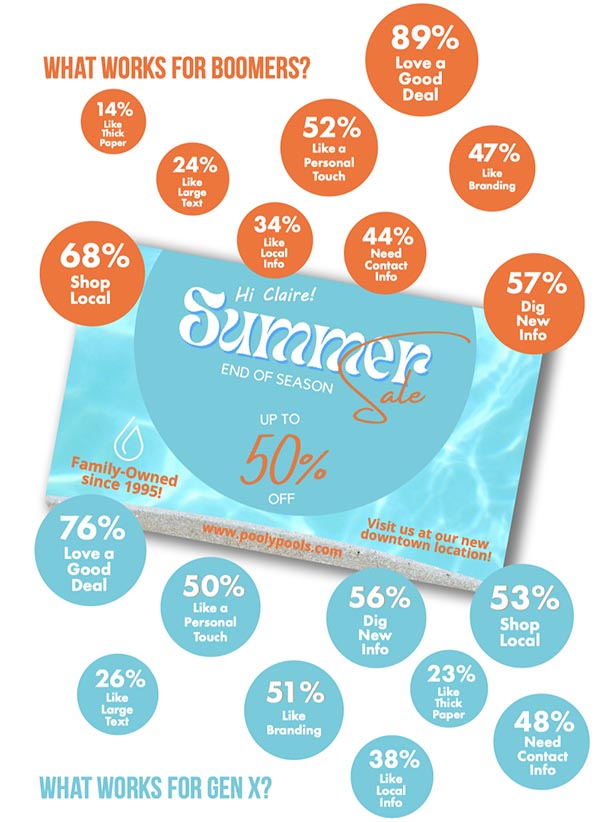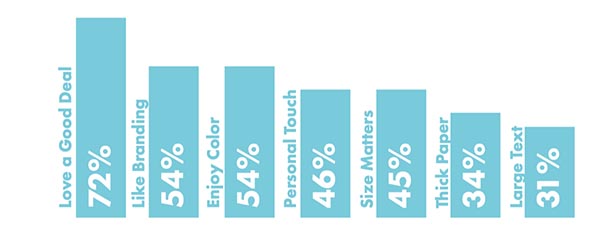Nobody knows more about direct mail than the United States Postal Service, and it regularly puts out surveys designed to help businesses and mailers better understand their customers so they can get better results.
As part of these efforts, the USPS conducted the “Generational Research Report,” which shows who’s reading what and what elements of direct mail are most important to which generations. Think of it as that generation’s direct mail fingerprint. Here are some highlights.
Baby Boomers—1946–1964
This generation was 57–76 years old in 2022. They make up 21% of the population and hold 70% of the disposable income in the United States. They also love direct mail. More than any other generation, boomers prefer to read promotional communications via direct mail rather than email. They are also the most likely to read catalogs.
Do boomers prefer direct mail because they are less digitally savvy? No, those days are gone. Today, it’s culture, preference, and maybe even a little bit of personal boundaries. These consumers have lived a lot of life and earned the right to receive communications on their own terms.
When these consumers do receive mail, what elements do they see as making their mail most effective?
More than one-third of boomers say they have visited a brand’s website after receiving a piece of “relevant” mail. If you are going to send retargeted direct mail, however, they expect those communications to contain better deals than they would have gotten in the store.
Generation X—1965–1980
This generation was born between 1965 and 1980, making them 42–57 years old in 2022. They make up 19% of the population and have the highest post-tax incomes of any demographic, outspending millennials and baby boomers by 41% and 18%, respectively.
What elements of direct mail are most effective with Gen X consumers? These consumers are
slightly less likely to focus on deals and locally owned businesses than baby boomers. They like mail to make them feel special, with thicker papers and unique sizes or shapes.
Forty-five percent recognize that they have received a retargeted direct mail piece, and like boomers, they expect any retargeting to contain a better deal than they would have received otherwise.

Millennials—1981–1996
This group was 25–41 years old in 2022 and comprise nearly 22% of the U.S. population. For 67% of this generation, finances are “a frequent worry.” How do they prefer to receive promotional communications?
More than any other generation, millennials prefer to receive promotional deals through email. However, it is notable that nearly one-third (32%) prefer postal mail. So much for millennials not being interested in print!
Fifty-three percent of millennials are aware that they’ve received retargeted direct mail, and after learning how it works, 64% said they would be likely to read it. Millennials also have the best perception of retargeted mail, with 57% saying they enjoy receiving retargeted direct mail pieces.

Generation Z—1997–2012
This generation (today’s teenagers and young twentysomethings) make up 20% of the U.S. population. They are just starting to enter the workforce, so while they have pocketbooks, targeting Gen Z is a long game.
Gen Z is a digital native generation, yet they also enjoy direct mail. For them, it provides an interesting, tangible experience that texts and emails can’t provide. One-third (33%) are inclined
to make a purchase if they see it in the mail. Gen Z consumers are also the most likely to be enticed by unusual mail pieces—those with unique sizes or shapes. Thicker paper grabs their attention, as well.
As a highly creative generation that grew up surrounded by creative tools, from TikTok to Instagram, it’s not surprising that Gen Z responds to the more innovative, eye-catching elements of direct mail.


Direct Mail Still Works
Direct mail still works. In fact, when the USPS asked about actions taken as a result of receiving a relevant mailpiece, the numbers were impressive. More than four in 10 (42%) respondents took at least some action, even if it was just going to the company’s website.
In this data, we also see that direct mail has the power to motivate recipients to some other sort of action, as well. This includes going to a new location to shop, making a purchase, and making a purchase after receiving a reminder in the mail. The data does vary by generation, but not as significantly as one might expect.
Surveys like the USPS “Generational Study” also remind us that no demographic group is homogenous, and in some ways, provide insights that challenge conventional thinking. In this case, the generation with the most disposable income is the most likely to want their direct mail pieces to contain discounts, while the generation most concerned about finances ranks it number one, but 17 points lower. The most digital native generation is less likely to focus on digital “extras” (such as augmented reality) than their older counterparts, and the youngest generation is the most likely to desire oversized type than the oldest.
This reminds us not to make assumptions, to do your research, and if the data surprise you or don’t make sense…dig deeper!










Discussion
Join the discussion Sign In or Become a Member, doing so is simple and free